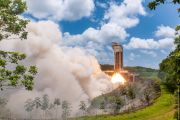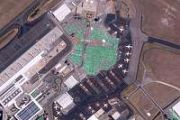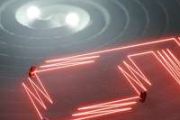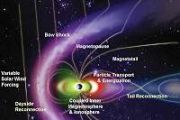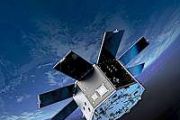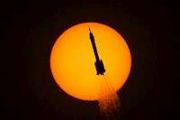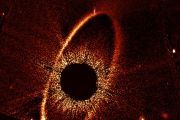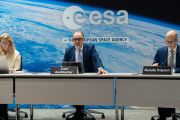
Copernical Team
Brazil gears up to harness ESA’s Biomass data

As the COP30 climate conference gets underway in Brazil, the world’s attention is once again drawn to the plight of the Amazon – the planet’s largest and most vital rainforest. With the European Space Agency’s Earth Explorer Biomass satellite now in orbit, ESA is helping Brazil prepare to transform this new mission’s groundbreaking data into actionable knowledge for protecting the rainforest and confronting climate change.
Copernicus Sentinel-6B pre-launch media briefing
 Video:
00:49:31
Video:
00:49:31
Copernicus Sentinel-6B, a sea-level monitoring satellite, is due to be launched no earlier than 17 November. Officials from ESA, the European Commission, EUMETSAT, NASA and marine applications users are set to share the latest information about this exciting mission and to be on-hand to answer questions.
Watch: Sentinel-6B launch live broadcast

Sentinel-6B, the next sea-level monitoring satellite for the Copernicus Earth observation programme, is ready for launch at the Vandenberg Space Force Base in California in just a few days. Here’s how you can watch the liftoff live on ESA Web TV.
Distant Siblings Revealed as Pleiades Star Cluster Expands
 Astronomers at the University of North Carolina at Chapel Hill have determined the Pleiades star cluster extends far beyond its well-known core, revealing thousands of stellar siblings previously undetected. By analyzing data from NASA's Transiting Exoplanet Survey Satellite and the European Space Agency's Gaia space telescope, the research team identified a widespread stellar association surrou
Astronomers at the University of North Carolina at Chapel Hill have determined the Pleiades star cluster extends far beyond its well-known core, revealing thousands of stellar siblings previously undetected. By analyzing data from NASA's Transiting Exoplanet Survey Satellite and the European Space Agency's Gaia space telescope, the research team identified a widespread stellar association surrou Hydroponic plant factories enable continuous urban edamame harvest
 Researchers in Japan achieved year-round indoor cultivation of edamame using hydroponic nutrient film technique and LED lighting. Controlled plant factories allow crops to grow independently of outdoor climate by regulating light, temperature, humidity, carbon dioxide, and nutrients. This approach bypasses the usual challenges of open-field farming for legumes, which include lengthy growth cycle
Researchers in Japan achieved year-round indoor cultivation of edamame using hydroponic nutrient film technique and LED lighting. Controlled plant factories allow crops to grow independently of outdoor climate by regulating light, temperature, humidity, carbon dioxide, and nutrients. This approach bypasses the usual challenges of open-field farming for legumes, which include lengthy growth cycle Europe hosts first in-orbit satellite cybersecurity competition
 D-Orbit, a leader in orbital logistics, together with mhackeroni, a prominent ethical hacking team, concluded CTRLSpace CTF, Europe's first cybersecurity competition using an operational spacecraft as the testbed. The event, supported by ESA's Security Cyber Centre of Excellence and Security Office, culminated at ESA ESTEC in the Netherlands, where five teams participated in live scenarios aboar
D-Orbit, a leader in orbital logistics, together with mhackeroni, a prominent ethical hacking team, concluded CTRLSpace CTF, Europe's first cybersecurity competition using an operational spacecraft as the testbed. The event, supported by ESA's Security Cyber Centre of Excellence and Security Office, culminated at ESA ESTEC in the Netherlands, where five teams participated in live scenarios aboar Europe Faces Satellite Espionage Threat from Russia and China
 Germany and the United Kingdom have raised alarms regarding the escalating danger posed by Russian and Chinese activity in space, with recent incidents putting focus on the growing threat to Western satellites. Both countries have publicly accused Russia of stalking, jamming, and interfering with their orbital systems, while experts have warned that China's rapid technological advances could wie
Germany and the United Kingdom have raised alarms regarding the escalating danger posed by Russian and Chinese activity in space, with recent incidents putting focus on the growing threat to Western satellites. Both countries have publicly accused Russia of stalking, jamming, and interfering with their orbital systems, while experts have warned that China's rapid technological advances could wie European Response to Escalating Space Security Crisis
 Facing a new era of satellite surveillance and jamming, European governments are moving rapidly to strengthen their defenses in orbit. The twin challenges posed by Russian and Chinese activities have forced the continent to confront longstanding vulnerabilities in both military and civilian space infrastructure. While much of the public discourse addresses threats, a parallel focus has emerged:
Facing a new era of satellite surveillance and jamming, European governments are moving rapidly to strengthen their defenses in orbit. The twin challenges posed by Russian and Chinese activities have forced the continent to confront longstanding vulnerabilities in both military and civilian space infrastructure. While much of the public discourse addresses threats, a parallel focus has emerged: BlackSky to deliver advanced Gen-3 tactical ISR capabilities to international customer
 BlackSky Technology Inc. (NYSE: BKSY) has announced the award of a contract worth more than $30 million spanning several years, focused on integrating its third-generation high-cadence tactical intelligence, surveillance, and reconnaissance services into a strategic international defense customer's secure operational environment.
The awarded project accelerates the customer's sovereign spa
BlackSky Technology Inc. (NYSE: BKSY) has announced the award of a contract worth more than $30 million spanning several years, focused on integrating its third-generation high-cadence tactical intelligence, surveillance, and reconnaissance services into a strategic international defense customer's secure operational environment.
The awarded project accelerates the customer's sovereign spa Next-generation GHGSat satellites to expand commercial greenhouse gas monitoring
 SFL Missions Inc. has secured a contract from GHGSat, Montreal, to supply two additional commercial microsatellites for the GHGSat greenhouse gas monitoring constellation. The satellites, designated GHGSat-C18 and GHGSat-C19, are in development at SFL Missions' Toronto facility, which is currently working on 37 satellites for clients in the commercial, government, and research sectors.
GHG
SFL Missions Inc. has secured a contract from GHGSat, Montreal, to supply two additional commercial microsatellites for the GHGSat greenhouse gas monitoring constellation. The satellites, designated GHGSat-C18 and GHGSat-C19, are in development at SFL Missions' Toronto facility, which is currently working on 37 satellites for clients in the commercial, government, and research sectors.
GHG 












